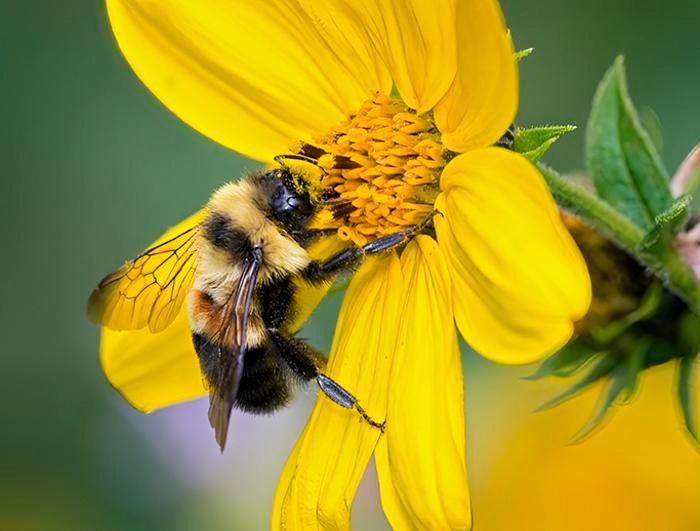Reviewed by Danielle Ellis, B.Sc.Jun 20 2023
Scientists from the United States Department of Agriculture (USDA) Agricultural Research Service (ARS) and the United States Fish and Wildlife Service (USFWS) have released a comprehensive, high-resolution map of the rusty patched bumble bees’ genome, supplying new approaches for saving the native pollinator from extinction.
 Rusty patched bumble bee (Bombus affinis). Image Credit: Clay Bolt
Rusty patched bumble bee (Bombus affinis). Image Credit: Clay Bolt
The rusty patched bumble bee genome is being assembled as part of the Beenome 100 project, a groundbreaking endeavor to produce a library of high-quality, extremely detailed genomic maps of 100 or more varied bee species present in the United States.
Beenome 100 is a joint project between ARS and the University of Illinois. This library is expected to aid researchers in answering big issues about bees, such as what genetic characteristics make a bee species more vulnerable to climate change or if a bee species is more likely to be susceptible to a pesticide.
The rusty patched bumble bee (Bombus affinis) pollinates bergamot (Monarda fistulosa), milkweed, and other wildflowers as well as crops like cranberries, plums, apples, and alfalfa. However, its population has dropped by 87% in the previous 20 years or so.
In 2017, the species was declared “endangered.” Rusty patched bumble bees were originally prevalent across the Upper Midwest and Northeast in 28 states and two Canadian provinces, but their range has shrunk to 13 states and one Canadian province.
The Minneapolis-St. Paul area of Minnesota and Wisconsin are among the few areas where they can still be found on a regular basis.
With the amount of detailed information that we and other researchers now have access to in this newly sequenced genome, we have an opportunity to find a whole different approach to strengthening rusty patched bumble bee populations.”
Jonathan B. Uhaud Koch, Research Entomologist, Utah State University
Some of the factors contributing to the reduction of rusty patched bumble bees are previously recognized, according to Koch, including habitat loss, a limited range of nectar sources, climate change, pesticide exposure, and more infections and pests.
While scientists have long known that the fungal pathogen Varimorpha bombi (formerly known as Nosema bombi) has a negative impact on many rusty patched bumble bee populations, Koch was surprised by how much Varimorpha genetic material he discovered in the bumble bee sample utilized to create the genome map.
Koch added, “We used a small piece of abdominal tissue from a single male collected from a nest in Minnesota, which, given the endangered status of the rusty patched bumble bee, seemed like a very good idea. It is only with the most cutting-edge equipment that you could resolve an entire genome of 15,252 genes and 18 chromosomes from a tiny bit of one bumble bee.”
It turns out that around 4.5% of the DNA sequenced by the researchers comes from Microsporidia, a fungus genus that includes Varimorpha bombi.
“That is a massive amount of genetic information from the bee tissue sample to be associated with Varimorpha bombi. It demonstrates how pervasive the pathogen is,” Koch further stated.
He continued, “Having this high-quality genome will support the identification of genetic differences between rusty patched bumble bee populations that appear to be doing well versus where they are in decline. This may give us a handle on identifying the genes that give the more capable population its flexibility to deal with its environment. We may also gain a better understanding of the genetic basis of bumble bee behavior, physiology and adaptation to changing environmental conditions.”
Researchers will be able to steer a population in the appropriate direction when it comes to reintroducing the rusty patched bumble bee to an area through captive breeding programs once the more effective genes for a specific kind of local condition are discovered.
Source:
Journal reference:
Koch, J. B. U., et al. (2023). Chromosome-scale genome assembly of the rusty patched bumble bee, Bombus affinis (Cresson) (Hymenoptera: Apidae), an endangered North American pollinator. G3: Genes|Genomes|Genetics. doi.org/10.1093/g3journal/jkad119